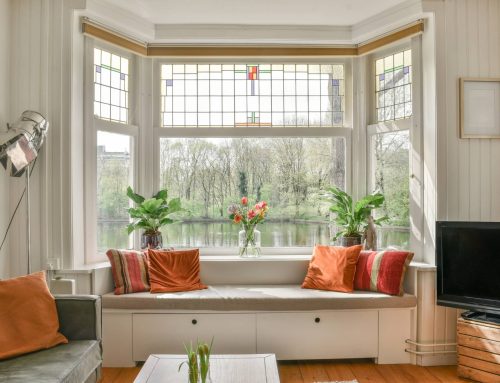A well-lit home can provide you with several benefits. Bright spaces feel inviting, spacious, and clean and bring out the beauty and aesthetics of your home. In addition, visually appealing rooms encourage social interactions and gatherings. Rooms and spaces with abundant natural light can positively impact your mood and mental well-being and can foster an environment for better concentration and focus. Functionally, a room with optimal lighting conditions can be used for activities that require attention to detail. With sufficient lighting, you will not need to strain your eyes or use artificial lighting during the day. Improving your home’s natural lighting can contribute to an energy efficient home and lead to more energy savings.
Windows and doors are essential for bringing light into your home. Replacement windows and doors, mirrors and reflective surfaces, and lightweight window treatments can work together to enhance the natural light in your home. Here are five ways you can maximize the light in your home:
1. Optimal Window Size and Placement
In the northern hemisphere, east-facing windows receive direct sunlight in the mornings while west-facing windows receive direct sunlight in the afternoons. South-facing windows tend to receive consistent direct sunlight throughout the day while north-facing windows tend to receive indirect sunlight during the day. Since north and south-facing windows tend to receive consistent light throughout the day, placing larger windows on the north and south-facing walls of your home will allow more daylight to enter your home. On the other hand, east and west-facing windows receive direct sunlight during specific times of the day and can result in significant heat gain during those corresponding times. Placing smaller windows on the east and west-facing walls can control the quality and distribution of direct light and heat coming from these directions. By placing appropriately sized windows in strategic locations, you can maximize the amount of natural light your home can receive throughout the day.
2. Expansive Glass Panels and Door Designs
When choosing windows, consider selecting styles with large glass panels. These will allow large amounts of light to enter your home throughout the day. As for doors, select door designs that create large openings or incorporate glass inserts. Bi-fold and multi-slide doors can allow plenty of light to enter your home as well as provide you with expansive views of the outdoors. Doors that are designed with glass panels can maximize light as well as enhance your home’s aesthetic appeal. For indoor spaces, using sliding glass doors or glass dividers instead of walls can create distinct spaces while maximizing the amount of natural light various rooms receive throughout the day.
3. Energy-Efficient Window and Door Glazing
By selecting windows and doors with energy-efficient glazing, you can enjoy the benefits of natural light while maintaining a comfortable indoor environment. Energy-efficient glazing will allow high amounts of visible light to enter your home yet block a significant amount of heat from the sun. Pairing energy-efficient glass panels with energy-efficient window frames can enhance the insulation of your windows and maximize the glass area and allow more light to enter your home. If preferred, you can also opt to use tinted or reflective energy-efficient glazing, which can reduce glare and excessive brightness and provide some privacy for your home. When selecting windows, it is also important to consider the area’s climate, the window’s orientation, and your home’s overall design.
4. Mirrors and Reflective Surfaces
Strategically placing mirrors and reflective surfaces can maximize the amount of light your home receives. Mirrors and reflective surfaces can bounce and amplify light in rooms. Placing mirrors or reflective surfaces in darker or narrower spaces, such as hallways, corridors, or bathrooms, can create an illusion of spaciousness and brightness. In addition, mirrors and reflective surfaces can serve as decorative elements that can enhance your home’s visual appeal. When placing mirrors and other reflective elements within your home, it is important to consider the overall effect. However, too many mirrors or reflective ornaments could lead to glare and discomfort. Strategic size and placement are important when using mirrors and reflective surfaces to maximize the light in your home.
5. Sheer or Lightweight Window Treatments
Window treatments, such as curtains, drapes, blinds, or shades, are used for both functional and decorative purposes. Window treatments can block excessive light and provide privacy for your home. When it comes to maximizing your home’s light, consider opting for sheer or lightweight window treatments. Sheer window treatments allow you to maintain a level of privacy in your home by partially obscuring the view from outside while still allowing you to see outside. Furthermore, sheer fabrics and treatments can diffuse light and block glare from the sun. Lightweight window treatments can help block the sun’s heat while still allowing a significant amount of light to enter the room. Window treatments can contribute to a room’s aesthetic appeal as well as its energy efficiency and create a comfortable indoor environment in your home.
It may be helpful to consult a professional who can recommend the appropriate windows and doors to suit your needs and preferences. From there, you can choose window treatments and decorative items to maximize your home’s natural light and to enhance its aesthetic appeal.






